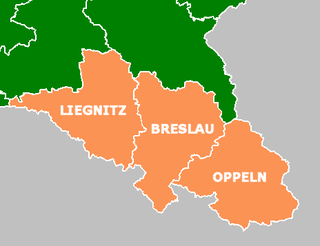Loading AI tools
Province of Prussia From Wikipedia, the free encyclopedia
The Province of Lower Silesia (German: Provinz Niederschlesien; Silesian German: Provinz Niederschläsing; Polish: Prowincja Dolny Śląsk; Silesian: Prowincyjŏ Dolny Ślōnsk) was a province of the Free State of Prussia from 1919 to 1945. Between 1938 and 1941 it was reunited with Upper Silesia as the Province of Silesia. The capital of Lower Silesia was Breslau (now Wrocław in Poland). The province was further divided into two administrative regions (Regierungsbezirke), Breslau and Liegnitz.[1]
This article needs additional citations for verification. (January 2008) |
| Province of Lower Silesia | |||||||||||||
|---|---|---|---|---|---|---|---|---|---|---|---|---|---|
| Province of Prussia | |||||||||||||
| 1919–1938 1941–1945 | |||||||||||||
 Province of Lower Silesia (red) within the Free State of Prussia. | |||||||||||||
 | |||||||||||||
| Capital | Breslau (Wrocław) | ||||||||||||
| Area | |||||||||||||
• 1925 | 26,616 km2 (10,276 sq mi) | ||||||||||||
| Population | |||||||||||||
• 1925 | 3,132,135 | ||||||||||||
| History | |||||||||||||
• Established | 1919 | ||||||||||||
• Merged into Province of Silesia | 1938–1941 | ||||||||||||
• Disestablished | 1945 | ||||||||||||
| |||||||||||||
| Today part of | Germany Poland | ||||||||||||
The province was not congruent with the historical region of Lower Silesia, which now lies mainly in Poland. It additionally comprised the Upper Lusatian districts of Görlitz, Rothenburg and Hoyerswerda in the west, that until 1815 had belonged to the Kingdom of Saxony, as well as the former County of Kladsko in the southeast.
The province was disestablished at the end of World War II and with the implementation of the Oder–Neisse line in 1945, the area east of the Neisse river fell to the Republic of Poland. The smaller western part was incorporated into the German states of Saxony and Brandenburg.


During the Polish post-war census of December 1950, data about the pre-war places of residence of the inhabitants as of August 1939 was collected. In case of children born between September 1939 and December 1950, their origin was reported based on the pre-war places of residence of their mothers. Thanks to this data it is possible to reconstruct the pre-war geographical origin of the post-war population. The same area corresponding to pre-1938 Province of Lower Silesia east of the Oder-Neisse line (which became Polish in 1945) was inhabited in December 1950 by:
| Region (within 1939 borders): | Number | Percent |
|---|---|---|
| Autochthons (1939 DE/FCD citizens) | 120,885 | 6,1% |
| Polish expellees from Kresy (USSR) | 696,739 | 35,3% |
| Poles from abroad except the USSR | 91,395 | 4,6% |
| Resettlers from the City of Warsaw | 61,862 | 3,1% |
| From Warsaw region (Masovia) | 69,120 | 3,5% |
| From Białystok region and Sudovia | 23,515 | 1,2% |
| From pre-war Polish Pomerania | 54,564 | 2,8% |
| Resettlers from Poznań region | 172,163 | 8,7% |
| Katowice region (East Upper Silesia) | 66,362 | 3,4% |
| Resettlers from the City of Łódź | 16,483 | 0,8% |
| Resettlers from Łódź region | 96,185 | 4,9% |
| Resettlers from Kielce region | 141,748 | 7,2% |
| Resettlers from Lublin region | 70,622 | 3,6% |
| Resettlers from Kraków region | 156,920 | 7,9% |
| Resettlers from Rzeszów region | 110,188 | 5,6% |
| place of residence in 1939 unknown | 26,586 | 1,3% |
| Total pop. in December 1950 | 1,975,337 | 100,0% |
Over 90% of the 1950 inhabitants were new to the region, with less than 10% residing in the province already back in August 1939 (so called autochthons, who had German citizenship before World War II and were granted Polish citizenship after 1945). The largest group among new inhabitants were Poles expelled from areas of Eastern Poland annexed by the USSR. The second largest group came from Southern Poland (from Kraków, Rzeszów, Lublin, Kielce and Katowice regions in total 28%) followed by Greater Poland. Many Poles from Bosnia settled around Bolesławiec.
Seamless Wikipedia browsing. On steroids.
Every time you click a link to Wikipedia, Wiktionary or Wikiquote in your browser's search results, it will show the modern Wikiwand interface.
Wikiwand extension is a five stars, simple, with minimum permission required to keep your browsing private, safe and transparent.